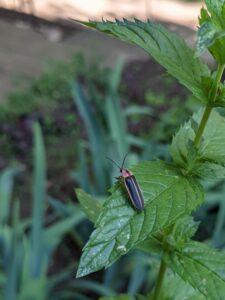 As I was having a beer on our front steps after my daily bike ride, a lightning bug landed on a leaf in a pot of mint on one of the steps. It stayed there for some time (it may be there still), but it did nothing but sit. In other words, it was not munching mint. And it got me wondering: what do fireflies (their other name) eat?
As I was having a beer on our front steps after my daily bike ride, a lightning bug landed on a leaf in a pot of mint on one of the steps. It stayed there for some time (it may be there still), but it did nothing but sit. In other words, it was not munching mint. And it got me wondering: what do fireflies (their other name) eat?
In years gone by, this simple question would probably have required a significant expenditure of time and a healthy bit of work to answer, probably a trip to the library—unless one happened to have an entomologist or an amateur lightning bug expert at one’s elbow. But since this is now, and since my cellphone was at hand, the answer was also within immediate reach.
Judging from the query autocompletion at Google, it is clear I am not the first person, by far, to ask this question. And part of the answer is, frankly, a little disturbing.
According to the National Wildlife Federation, “[f]irefly larvae eat snails, worms, and slugs, which they inject with a numbing chemical to disable.” So far so good (unless you’re a snail, worm, or slug). The entry continues: “Adults eat other fireflies, nectar, or pollen, although some don’t eat at all.”
Fireflies eat other fireflies! Lightning bugs are cannibals!
Am I the better for knowing this?
Well (I tell myself), maybe this is one of those who “don’t eat at all.”


Sadly, fireflies are under duress. One way to help them: turn off your outdoor lights at night. (Of course at night—when else would they be on?!)